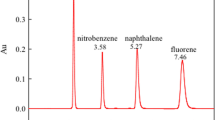Abstract
This study is a preliminary experiment to examine the effect of amines as additive in eluents for separating neighboring lanthanides (Lu and Yb) for efficiently producing carrier-free 177Lu. The separation method was based on cation-exchange chromatography and the pH-adjusted eluent with NH4OH or several amines. Among the amines, methylamine exhibited a longer retention time than NH4OH, and proved to be the most effective additive for separation resolution and purification. The optimized chromatographic parameters were able to effectively separate Lu from a large amount (100 mg) of Yb on a relatively short column (15 mm × 70 mm).
Graphical abstract
The effect of pH adjusting additive on the separation of adjacent lanthanides Yb and Lu was investigated with different amines. The separation efficiency was improved by using CH3NH2 instead of NH4OH as the pH adjusting additive. These results indicate that the role of the protonated amines as a physically exchangeable cation is important for the efficient separation of the lanthanide ions adsorbed on the resin.





Similar content being viewed by others
References
Balaram V (2019) Rare earth elements: a review of applications, occurrence, exploration, analysis, recycling, and environmental impact. Geosci Front 10:1285–1303
Naumov AV (2008) Review of the world market of rare-earth metals. Russ J Non-Ferr Met 49:14–22
Eliseeva SV, Bünzli JCG (2010) Lanthanide luminescence for functional materials and bio-sciences. Chem Soc Rev 39:189–227
Binnemans K, Jones PT, Blanpain B, Van Gerven T, Yang Y, Walton A, Buchert M (2013) Recycling of rare earths: a critical review. J Clean Prod 51:1–22
Robards K, Clarke S, Patsalides E (1988) Advances in the analytical chromatography of the lanthanides. A review Analyst 113:1757–1779
Smith HL, Hoffman DC (1956) Ion-exchange separations of the lanthanides and actinides by elution with ammonium alpha-hydroxy-isobutyrate. J Inorg Nucl Chem 3:243–247
Choppin GR, Chopoorian JA (1961) Complexes of the lanthanide elements with α-hydroxy carboxylate ligands. J Inorg Nucl Chem 22:97–113
Van de Voorde M, Van Hecke K, Cardinaels T, Binnemans K (2019) Radiochemical processing of nuclear-reactor-produced radiolanthanides for medical applications. Coord Chem Rev 382:103–125
Mishiro K, Hanaoka H, Yamaguchi A, Ogawa K (2019) Radiotheranostics with radiolanthanides: design, development strategies, and medical applications. Coord Chem Rev 383:104–131
Banerjee S, Pillai MRA, Knapp FF (2015) Lutetium-177 therapeutic radiopharmaceuticals: Linking chemistry, radiochemistry, and practical applications. Chem Rev 115:2934–2974
Dash A, Pillai MRA, Knapp FF (2015) Production of 177Lu for targeted radionuclide therapy: available options. Nucl Med Mol Imaging 49:85–107
Nayak D, Lahiri S (1999) Separation of the carrier free radioisotopes of lanthanide series elements. Solvent Extr Ion Exch 17:1133–1154
Lahiri S, Nayak D, Nandy M, Das NR (1998) Separation of carrier free lutetium produced in proton activated ytterbium with HDEHP. Appl Radiat Isot 49:911–913
Lebedev NA, Novgorodov AF, Misiak R, Brockmann J, Rösch F (2000) Radiochemical separation of no-carrier-added 177Lu as produced via the 176Yb(n, γ)177Yb→177Lu process. Appl Radiat Isot 53:421–425
Horwitz EP, McAlister DR, Bond AH, Barrans RE, Williamson JM (2005) A process for the separation of 177Lu from neutron irradiated 176Yb targets. Appl Radiat Isot 63:23–36
Van So Le, Morcos N, Zaw M, Pellegrini P, Greguric I, Nevissi A (2008) Alternative chromatographic processes for no-carrier added 177Lu radioisotope separation. Part II. The conventional column chromatographic separation combined with HPLC for high purity. J Radioanal Nucl Chem 277:675–683
Bilewicz A, Żuchowska K, Bartoś B (2009) Separation of Yb as YbSO4 from the 176Yb target for production of 177Lu via the 176Yb(n, γ)177Yb→177Lu process. J Radioanal Nucl Chem 280:167–169
Chakravarty R, Das T, Dash A, Venkatesh M (2010) An electro-amalgamation approach to isolate no-carrier-added 177Lu from neutron irradiated Yb for biomedical applications. Nucl Med Biol 37:811–820
Balasubramanian PS (1994) Separation of carrier-free lutetium-177 from neutron irradiated natural ytterbium target. J Radioanal Nucl Chem 185:305–310
Hashimoto K, Matsuoka H, Uchida S (2003) Production of no-carrier-added 177Lu via the 176Yb(n, γ)177Yb → 177Lu process. J Radioanal Nucl Chem 255:575–579
Watanabe S, Hashimoto K, Watanabe S, Iida Y, Hanaoka H, Endo K, Ishioka NS (2015) Production of highly purified no-carrier-added 177Lu for radioimmunotherapy. J Radioanal Nucl Chem 303:935–940
Tompkins ER, Khym JX, Cohn WE (1947) Ion-exchange as a separations method. I. The separation of fission-produced radioisotopes, including individual rare earths, by complexing elution from Amberlite resin. J Am Chem Soc 69:2769–2777
Dadachova E, Mirzadeh S, Lambrecht RM, Hetherington EL, Knapp FF (1994) Separation of carrier-free holmium-166 from neutron-irradiated dysprosium targets. Anal Chem 66:4272–4277
Bene BJ, Taylor WA, Birnbaum ER, Sudowe R (2017) Chromatographic separation of thulium from erbium for neutron capture cross section measurements—Part II: Preparative scale separation. J Radioanal Nucl Chem 311:155–163
Frei RW, Jansen H, Brinkman UATh (1985) Postcolumn reaction detectors for HPLC. Anal Chem 57:1529A-1539A
Acknowledgements
This study was supported by Nuclear R&D Program, Development of Production Standardized Production Technology for Theranostic RI (57831-21).
Author information
Authors and Affiliations
Corresponding author
Ethics declarations
Conflict of interest
All authors declare that they have no conflict of interest.
Additional information
Publisher's Note
Springer Nature remains neutral with regard to jurisdictional claims in published maps and institutional affiliations.
Supplementary Information
Below is the link to the electronic supplementary material.
Rights and permissions
About this article
Cite this article
Kim, A., Choi, K. Preparative chromatographic separation of neighboring lanthanides using amines as a pH adjusting additive for producing carrier-free 177Lu. J Radioanal Nucl Chem 331, 1451–1457 (2022). https://doi.org/10.1007/s10967-022-08216-1
Received:
Accepted:
Published:
Issue Date:
DOI: https://doi.org/10.1007/s10967-022-08216-1




